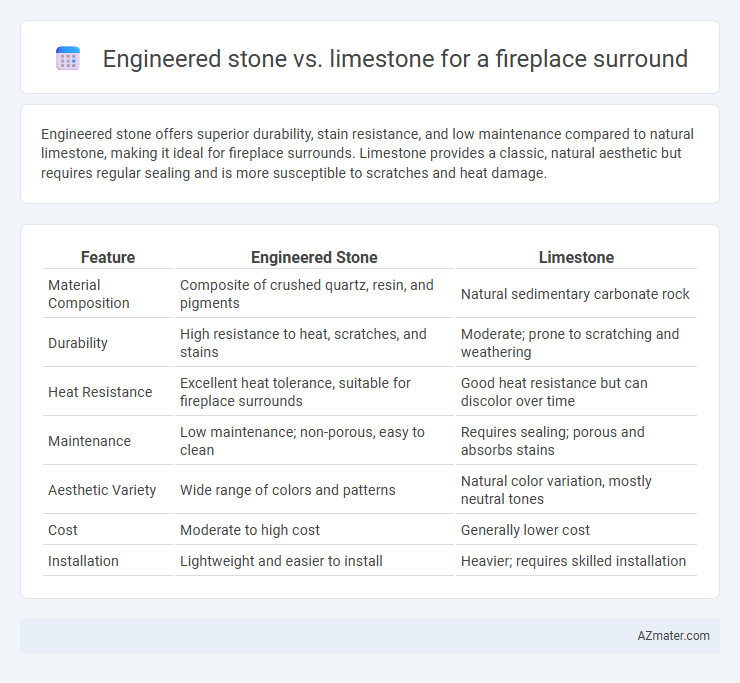Engineered stone offers superior durability, stain resistance, and low maintenance compared to natural limestone, making it ideal for fireplace surrounds. Limestone provides a classic, natural aesthetic but requires regular sealing and is more susceptible to scratches and heat damage.
Table of Comparison
| Feature | Engineered Stone | Limestone |
|---|---|---|
| Material Composition | Composite of crushed quartz, resin, and pigments | Natural sedimentary carbonate rock |
| Durability | High resistance to heat, scratches, and stains | Moderate; prone to scratching and weathering |
| Heat Resistance | Excellent heat tolerance, suitable for fireplace surrounds | Good heat resistance but can discolor over time |
| Maintenance | Low maintenance; non-porous, easy to clean | Requires sealing; porous and absorbs stains |
| Aesthetic Variety | Wide range of colors and patterns | Natural color variation, mostly neutral tones |
| Cost | Moderate to high cost | Generally lower cost |
| Installation | Lightweight and easier to install | Heavier; requires skilled installation |
Introduction: Engineered Stone vs Limestone Fireplace Surrounds
Engineered stone offers superior durability and stain resistance compared to natural limestone, making it a popular choice for fireplace surrounds that require low maintenance and long-lasting beauty. Limestone provides a classic, natural aesthetic with unique veining and texture but is softer and more porous, requiring regular sealing to prevent damage from heat and moisture. Both materials offer distinct visual appeal, with engineered stone excelling in performance and limestone favored for its authentic, timeless character.
Material Composition and Manufacturing Processes
Engineered stone for fireplace surrounds is composed of crushed natural stone bound with resin, creating a highly durable and non-porous surface through a controlled manufacturing process involving compression and curing. Limestone, a sedimentary rock primarily made of calcium carbonate, forms naturally over millions of years and is typically cut and polished for use, offering a softer, more porous surface that requires sealing. The precise resin blending and quality control in engineered stone manufacturing result in enhanced resistance to heat and stains compared to the more variable composition and natural weathering properties of limestone.
Aesthetic Differences: Colors, Patterns, and Finishes
Engineered stone offers a wide range of vibrant colors, consistent patterns, and sleek, polished finishes that create a modern and uniform appearance for fireplace surrounds. Limestone provides natural, earthy tones with subtle veining and a matte or honed finish, resulting in a warm, rustic, and timeless aesthetic. The choice between engineered stone and limestone significantly impacts the overall look, with engineered stone favoring contemporary designs and limestone enhancing traditional or classic interiors.
Durability and Longevity Comparison
Engineered stone offers superior durability and resistance to heat, scratches, and stains compared to limestone, making it ideal for fireplace surrounds exposed to high temperatures and frequent use. Limestone, while aesthetically appealing with its natural texture, is softer and more porous, prone to chipping and discoloration over time without proper sealing and maintenance. The long-term performance of engineered stone typically exceeds limestone, ensuring a lasting, low-maintenance fireplace surround.
Heat Resistance and Performance with Fireplaces
Engineered stone offers superior heat resistance compared to limestone, making it a preferred option for fireplace surrounds exposed to high temperatures. Its non-porous composition ensures better durability and less thermal shock, reducing the risk of cracking or discoloration over time. Limestone, while aesthetically pleasing, tends to absorb heat and is more susceptible to damage from prolonged exposure to fireplace heat, leading to faster wear and potential safety concerns.
Maintenance and Cleaning Requirements
Engineered stone offers high durability and stain resistance, requiring minimal maintenance with simple soap and water cleaning, making it ideal for fireplace surrounds exposed to soot and heat. Limestone demands more care due to its porous nature, necessitating regular sealing to prevent staining and specialized cleaners to avoid damage from acidic or abrasive substances. Choosing engineered stone reduces long-term upkeep and preserves the fireplace's appearance more effectively compared to limestone.
Installation Considerations and Complexity
Engineered stone offers a uniform size and weight that simplifies installation for fireplace surrounds compared to natural limestone, which demands more precise cutting and fitting due to its irregularities and variable density. Limestone requires specialized tools and skilled labor to handle its porous nature and fragility, increasing installation complexity and time. Engineered stone's consistent composition reduces risks of cracking during installation, making it a more straightforward option for efficient fireplace surround application.
Environmental Impact and Sustainability
Engineered stone for fireplace surrounds offers greater sustainability through its use of recycled materials and lower water consumption during manufacturing compared to limestone, which involves extensive quarrying that disrupts natural ecosystems. Limestone extraction generates higher carbon emissions and habitat degradation, making engineered stone a more environmentally responsible choice. Furthermore, engineered stone's durability reduces the need for replacement, enhancing its long-term environmental benefits over natural limestone.
Cost Comparison: Initial and Long-Term Investment
Engineered stone typically costs between $50 and $100 per square foot, offering a durable, low-maintenance option that resists stains and scratches, reducing long-term upkeep expenses. Limestone ranges from $30 to $70 per square foot initially but requires regular sealing and maintenance, increasing overall costs over time. When comparing initial investment and longevity, engineered stone often provides better value due to its durability and minimal maintenance needs.
Which Fireplace Surround Is Best for Your Home?
Engineered stone offers superior durability, non-porous surface, and a wide range of design options, making it ideal for high-traffic areas and homes seeking modern aesthetics. Limestone provides natural beauty with its unique textures and warm tones but requires more maintenance due to its porous nature and susceptibility to staining. Choosing the best fireplace surround depends on your home's style, maintenance preferences, and long-term durability needs.

Infographic: Engineered stone vs Limestone for Fireplace surround
 azmater.com
azmater.com